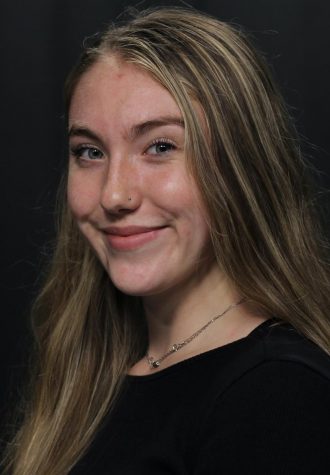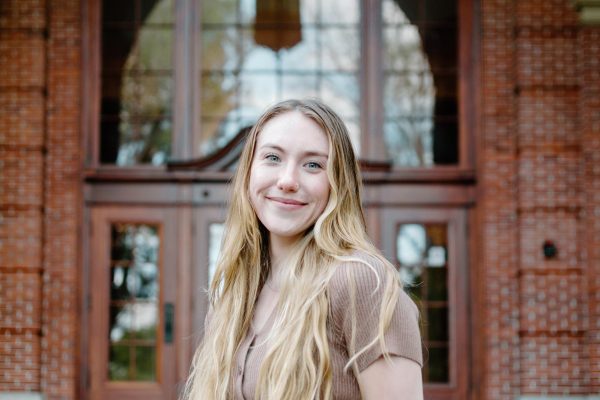On Our Minds: Omicron COVID-19 variant poses risk for students attending in-person classes
This illustration shows a backpack with school supplies along with a mask and hand sanitizer. Due to a high number of positive cases of COVID-19 because of the omicron variant, students and faculty have to make adjustments to prevent further spread of the virus.
January 29, 2022
 Editor’s Note: This column does not represent the opinion of The Daily Barometer. This column reflects the personal opinions of the writer.
Editor’s Note: This column does not represent the opinion of The Daily Barometer. This column reflects the personal opinions of the writer.
Oregon State University should not have returned immediately to in-person classes due to the rapid spread of the COVID-19 omicron variant, and some students now fear for their safety.
In just the first week of students returning to campus after winter break, the university recorded 785 positive cases with the following week finding another 641. Testing rates and positive case rates have fallen since the first two weeks of the winter term but remain higher than they were in the fall term.
Many other universities across the nation decided to begin their terms with a few weeks of remote learning to offset the spike in cases, with hopes of returning to in-person learning once the peak had subsided.
OSU, however, insisted on fully in-person learning for students beginning on Jan. 3 while asking instructors to be compassionate, but not specifically requiring hybrid options for students who may feel uncomfortable coming to a 300-person lecture or even a small recitation of just 15 other students.
When students have big lectures with many students it is easy to be exposed to the virus accidentally, but even in a class with fewer students, the physical space is often smaller as well, leaving the risk almost equally as high.
We as students, though, are given no option but to put ourselves in these risky situations if we want to continue our education.
“I think it is really difficult because we really want in-person classes but with the number of cases we’ve had I don’t think it’s necessarily viable at the moment,” said Michael Carris, a third-year computer science student at OSU.
According to Carris, the stress of deciding whether or not to go to class for personal concerns of contracting the virus or questioning his own exposure has definitely impacted his ability to stay focused this term so far.
Dan Larson, the vice provost for student affairs and OSU coronavirus response coordinator, said he acknowledges the difficulty for students to engage in-person or remotely during scenarios such as the professor needing to isolate or some students not being able to attend classes in person.
“In consultation with health authorities, the measures we have in place—vaccine and booster requirements, mask requirements and testing—are the appropriate measures and at this time allow the university to continue to offer in-person instruction,” Larson said.
Frustrations are still high though, as the email informing students of a booster requirement was released on Dec. 28—less than a week before classes began— an impossible ask for students who are home for such a short time.
Even though OSU is giving students until Feb. 15 to receive the booster, some students may have preferred to get their booster shot before the winter term started or while home for winter break.
“Communication has kind of dropped this term… it seems like it got worse,” Carris said. “What the university is doing with requiring the booster shot is nice, but I think they just didn’t give us enough time to do that, and there aren’t enough available nearby that it will protect everyone.”
Personally, if I had not already planned to get my booster when I did, I would have run out of time to do so over break, as I know many of my peers did. Now, as we are back on campus, many students are facing difficulty even finding locations to get their booster at, since there are no on-campus sites.
The university has done sufficient work to inform students of what to do if they are exposed or if they test positive, as well as continuing to provide on-campus testing locations.
“It’s nice that they have enough testing around, we just have a lot of cases, looking at the data,” Carris said.
Dave Kovac, a professor in the Honors College who teaches many international service-learning courses, had to begin winter term remotely after contracting the virus near the end of winter break.
“[Having COVID-19] had me scrambling a bit to rework some of my teaching materials for remote delivery while observing isolation protocols, but also made me more aware of the probability of students having to do the same,” Kovac said. “It creates a very different set of challenges and really stresses one’s creativity.”
However, not all courses and situations can be expected to change quickly or be modified to a remote format. If Kovac taught an in-person lab course, for example, the outcome for students would have been a much more significant and detrimental shift with little warning, through no fault of the professor but due to ambiguous guidance by the administration.
“Should certain classes or operations need to adjust to remote instruction based on staffing, guidance has been provided to guide those decisions,” Larson said.
The most recent update on protocols for a course to be conducted remotely informed students that a class will remain fully in-person unless the instructor deems the course better conducted in a remote format or they themselves need to isolate for a short period of time.
This kind of guidance not only leaves students like myself concerned and lacking consistency in what to expect or how to plan for the unexpected but also places the burden of student health on the instructor’s shoulders.
Carris said he wished the university held more open dialog including student voices in what worked best for our learning in the face of these trying and uncertain times.
“I wish they had taken a little bit more of a cautious approach, like maybe, ‘Before going back in person, let’s go online and see how online goes,’” Carris said. “I think that would have been a great preventive measure instead of it being reactionary.”












































































































